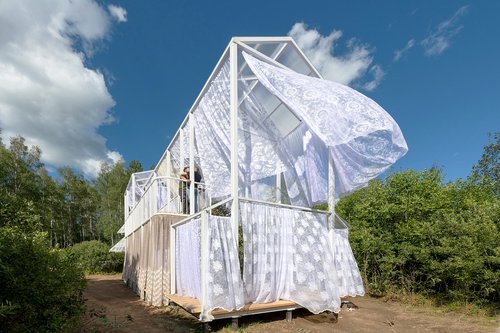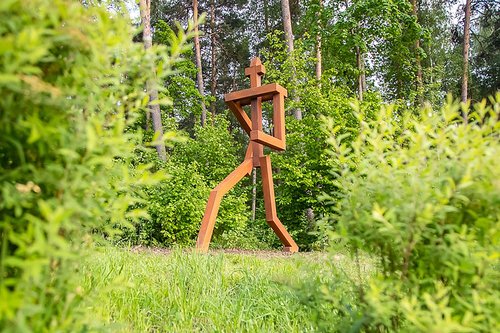Archstoyanie 2025. Nikola-Lenivets Art-park. Courtesy of Nikola-Lenivets Art-park. Photo by Varvara Yeretnova
Utopia in the Woods
Archstoyanie festival in the Kaluga region of Russia has just turned 20 years old. The anniversary edition at the end of July has taken the festival back to its architectural roots while keeping up the participatory vibe of the recent years.
Twenty years is an incredible lifespan for an independent, privately funded institution in Russia. Archstoyanie started as an initiative of a close-knit group of Moscow-based artists and architects who bought cottages in Nikola-Lenivets, a tiny village on the picturesque banks of the Ugra River, in the late 1980s. Over the past two decades, the event has grown into a full-scale institution and a rare example of 'cultural territory development' in Russia, where the enthusiasm of a small team has transformed a plot of land in the middle of nowhere into a popular year-round getaway destination.
Archstoyanie is a land art festival where artist Nikolay Polissky (b. 1957) created enormous sculptures out of perishable materials with the help of local peasants and his architect friends, who built absurd wooden structures that blended perfectly into the idyllic landscape. Highlights included a bed surrounded by a low fence reminiscent of those found in Russian graveyards (Untitled, 2006, by Alexander Brodsky, b. 1955, and Nadezhda Korbut), and a giant wooden ear overlooking the river where visitors could relax and enjoy the views and sounds of nature (Nikola's Ear, 2006, by Vlad Savinkin and Vladimir Kuzmin). The most spectacular artworks created at Nikola-Lenivets are regularly maintained and restored so many of these iconic early pieces are still there. However, most of the works of art either exist only during the festival, or rot away and are quietly dismantled within a few years.
Initially, Archstoyanie was primarily an event for Moscow's artistic community. This began to change when young curators Julia Bychkova and Anton Kochurkin came up with the idea of including a music programme to attract a wider audience. Archstoyanie soon became popular with die-hard party-goers, undeterred by mosquitoes, dirt roads and the arduous four-hour drive from Moscow. Although architects still take part in most iterations, over the years the focus of the event has shifted to the visual and performing arts. Top Russian and international artists are invited to create site-specific works, with varying levels of success, and both the founders and guest curators experiment with the concept of each festival. For instance, in 2019, no new objects were unveiled at all. Instead, visitors could enjoy five site-specific opera performances. In 2024, the distinction between visitors and participants became blurred: ‘camps’ were introduced where volunteer teams and institutions, chosen via an open call, could pitch their tents and offer free activities to the ever-growing crowd of attendees. This helped to keep visitors entertained during the day before the concerts and dancing began. In exchange for their services, campers received free admission to the event. Many of them had previously attended the festival as visitors. The camps offered a variety of activities, ranging from meditation and mindfulness to lectures on cinema without a screen and workshops on making goose-shaped hats. Campers were invited to participate in the “ceremonies” (collective performances) held on the main “square”, thereby contributing to the collective effort of making the festival happen.
To mark their 20th anniversary, the Archstoyanie team decided to revive the original concept. Polissky and Bychkova invited Vassily Bychkov, founder and director of several Moscow trade fairs, including Art Moscow art fair and the Arch Moscow architectural forum, to curate the festival. Polissky, meanwhile, curated the 30th anniversary edition of Arch Moscow. Guest curator Vassily Bychkov was no stranger to the Nikola-Lenivets community. He is Julia Bychkova's father and served in the army with Polissky in his youth. “I was asked to bring in as many architects as possible,” Bychkov explained at the festival's preview, “since the original concept was somewhat diluted by the participation of visual and performance artists.”
He chose the theme ‘What's Important To Me’ for the festival and became so inspired by the process that he designed three of the eighteen new works of art himself. A graduate of the Urban Planning Faculty at the Moscow Architectural Institute, he came up with the idea of a ‘white city’ comprising various facilities and monuments. This includes a school, a hospital, a museum, a central square (the Square of Ceremonies) and even a correctional facility where visitors can confront their conscience while sitting on low chairs in front of large mirrors.
There is also an alley of honour, where thirty-six leading Russian architects have created miniature monuments to themselves. This installation was first unveiled at Arch Moscow before being relocated to Nikola-Lenivets, so Bychkov was paying homage to a tradition that dated back to before the festival began. Many of the works of art in Nikola-Lenivets, starting with the Lighthouse (2004) by Polissky, are playful and delightfully crude caricatures of functional buildings – essentially, architectural jokes on a grand scale
Bychkov insisted that all the works commissioned for the anniversary edition should be painted white. However, the living classic Mikhail Belov (b. 1956) defiantly painted his cage-like ‘Abode’ grey. After the festival, he plans to relocate the structures and convert them into cages for farm animals in a kind of safari park. A group of colourful sculptures from an earlier series, ‘Totems of Childhood’ (2023) by Dima Shabalin (b. 1993), which happened to be located along the White City's main axis, were draped in white fabric. The rethinking and recycling of old objects and ideas was probably too obvious at this year's festival. However, a touch of retrospection is excusable in the anniversary edition. For his ‘Hospital’ project, Bychkov used beds left over from a similar installation, ‘Sanatorium of Dreams’ (2022), by Roman Sakin (b. 1976). Aristarkh Chernyshev (b. 1968) recreated his 2009 Aerial Port project, which he had originally created with Alexei Shulgin (b. 1963). The airport information board, which was placed on the edge of the forest, displayed flights to overseas destinations; none of these were cancelled or delayed.
This punctuality appeared darkly ironic in the summer of 2025, given that airports across central Russia have been disrupted almost daily by drone attacks since May. Even on the first night of the festival, an automated text message from the local authorities was sent to everyone's phone, warning of a drone attack in the Kaluga region. The local airport was closed for a few hours as a result. 'The context has changed, but I hope the borders will open and we will be able to travel all over the world again,' said the artist. This optimism resonates with the dreamlike, poetic nature of Bychkov’s White City, an array of surreal structures looming like ghosts against the backdrop of greenery.
The city's main axis begins at a utopian airport where, although the flights are invisible, they are always on time. It ends at the City Council, a steel sculpture by Boris Orlov (b. 1941), Sergei Shekhovtsov (b. 1969) and Sergei Yaralov (b. 1964). Resembling an organ, it makes no sound: in an ideal world, the voice of power is never heard. Instead, messages sent by the audience were displayed on a screen at the base of the sculpture. Typically, the biggest and most impressive object at the festival, though short-lived, was called ‘Polygon’ (‘A Mirage’), by Aleksander Shtanyuk, – three large white balloons anchored to the ground and floating above an enormous luminous net. At night, they resembled three moons, as if Nikola-Lenivets had been magically transported to a safer, saner planet.
Archstoyanie






























